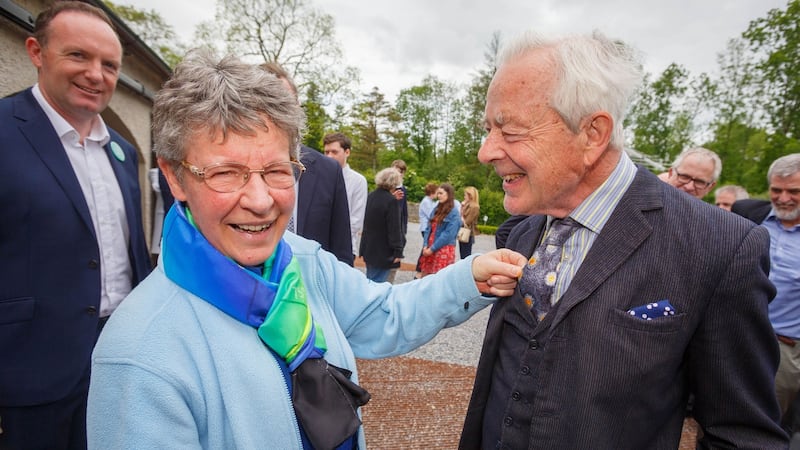When Dame Jocelyn Bell Burnell "stumbled on something new" during her PhD studies at Cambridge University, she was about to make what the Royal Society called "one of the greatest astronomical discoveries of the 20th century".
The strange “bit of scruff” she noticed in the data coming from the radio telescope she helped construct in a field outside Cambridge in 1967 while studying interplanetary scintillation of compact radio sources, was a radio pulsar.
“Pulsars are small pulsating radio stars, which are only about 10 miles across, and very dense because they’re formed when stars catastrophically explode,” she explains. Their beam can be likened to that of a lighthouse beam, and when it shines on a radio telescope, it can pick up a pulse. The discovery made her a star, despite missing out on a Nobel prize.
Born in Lurgan, Co Armagh, Bell was interested in science after reading an astronomy book her father had taken out of the library. Growing up in a Quaker household, she was raised "to believe she had as much right to an education as anyone else" and decided to pursue science early on, even though very few girls did so at the time.
Bell moved to York in the UK to attend a Quaker boarding school at the age of 13, where she took science subjects. After graduation, she attended the University of Glasgow, gaining a degree in physics in 1965 before getting accepted to Cambridge University’s New Hall to study quasars.
There is a committee who decides who gets the Nobel prize. Until then, they had never considered astronomy as physics
A luminous active galactic nucleus, quasars are powered by supermassive black holes, with mass ranging from millions to tens of billions times the mass of the sun. Bell was responsible for operating the telescope she helped build, and analysing its data. “This was before computers, so there was over 30 meters of paper to be looked at by hand every day.”
After completing her PhD, Bell got married and left Cambridge to raise her son and travel with her then husband around the UK, where his career took him.
She held a junior teaching fellowship at the University of Southampton, where she developed and calibrated a 1-10 million electron volt gamma ray telescope, before taking a research position teaching x-ray astronomy at the Mullard Space Science Laboratory in London.
In 1974, the discovery of radio pulsars earned her supervisor Anthony Hewish a Nobel Prize. For many, the omission appeared to be due to her gender, because at the time women were an anomaly in physics and astrophysics, but Bell attributed it to the fact that she was a PhD student at the time of the discovery in 1967 at the University of Cambridge.
“There is a committee who decides who gets the Nobel prize. Until then, they had never considered astronomy as physics.”
She says there were upsides to not winning the coveted award. “Once you win a Nobel prize, you won’t get any other prize, because others feel they won’t match up, but if you don’t, you’ll get lots of other prizes.”
She received the Oppenheimer Prize for "outstanding contributions to the theoretical natural sciences" in 1978, the Beatrice M Tinsley Prize from the American Astronomical Society in 1987, the Herschel Medal from the Royal Astronomical Society in 1989, while also winning the Michelson Medal and being knighted by the Queen in 2019.

Bell served as president of the Royal Astronomical Society between 2002 and 2004, and as president of the Institute of Physics from October 2008 to October 2010.
In 2018, she was awarded the Special Breakthrough Prize in Fundamental Physics, and gave the entirety of the £2.3 million prize money to help female, minority and refugee students seeking to become physics researchers. The scheme, administered by the Institute of Physics became known as the Bell Burnell Graduate Scholarship fund.
In 2021, she was awarded the Copley Medal, only the second female to ever win it after Dorothy Hodgkin won it in 1976. "Interestingly, she was a Quaker too," she says. She is currently a visiting professor of astrophysics at the University of Oxford where she studies neutron stars, and a fellow of Mansfield College.
About her Irish roots, Bell says; "I'm an honorary member of the Royal Dublin Society and come over for vacations. My family are from Dublin, and I really enjoyed visiting Ireland this past summer. A glorious day in Howth Head was a highlight. "
When asked about the final frontier of space knowledge – earth-like planets, Bell says there is progress. “We are finding a lot of planets around stars, and are trying to see if they support life,” she says.
Currently residing in Oxford, where she is still lectures, she says the universe still throws out more questions than answers. The pulsars she discovered in 1967, are used as proposed signposts for interstellar navigation and a map, which could direct aliens towards earth. Perhaps, in the decades to come, they could not just help scientists detect gravitational waves, but also communicate with alien lifeforms.















